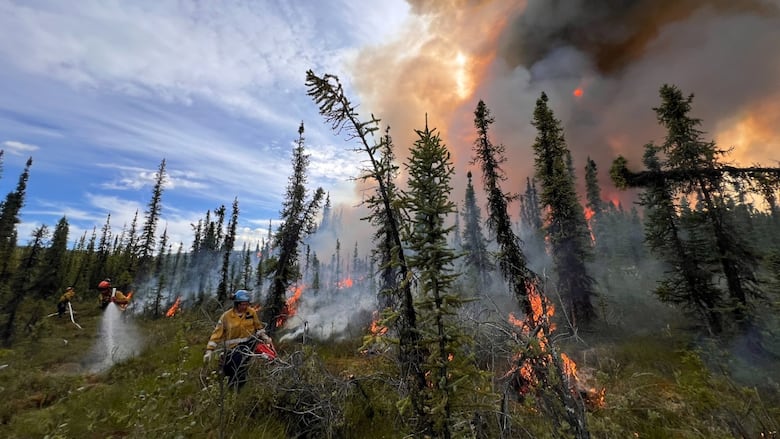Wildfire protection plans coming for many Yukon communities
At mid-season update, wildfire officials say it's been an intense summer for crews and communities

Yukon Wildland Fire Management says it's working with many of the territory's communities to develop wildfire protection plans.
Devin Bailey, the territory's director of Wildland Fire Management, said plans are already complete for Faro, Mayo and Dawson City. Plans are in the works for Watson Lake, Beaver Creek, Burwash Landing, and Destruction Bay.
"We want to complete this work before wildfires encroach on a community," said Bailey. "But if a fire is encroaching, we at least have a detailed plan with both local government and First Nations governments as a template to work from."
Bailey gave that update this week during a general wildfire news conference.
Wildfire officials said it's been a busy season — especially in the central region — and emphasized it's far from over.
Fire Information Officer Haley Ritchie said a spike in lightning activity kicked off the season.
"Thousands of new lightning strikes per day," said Ritchie. "At the peak, 19 new fires started in one day."
She said it's been an intense season for crews and communities.
"Some of our members did back to back shifts. So 14 days on, mandatory rest period, then back for another 14," said Ritchie.
Communities in Dawson, Mayo, and Beaver Creek all experienced evacuation alerts and disruptions, all of which have been rescinded.
Bailey said one of the challenges this season was how quickly fires grew.
"A fire will be one hectare when it's reported, and by the time we get there 25 to 30 minutes later … hot, dry conditions, combined with wind just made a lot of these fires beyond our resources very quickly."
Yukon also leaned heavily on partner organizations across Canada and the U.S.
One hundred and ninety-two firefighters and support staff were brought in to help from New Brunswick, Newfoundland, Prince Edward Island, British Columbia, Alberta, Washington, Idaho and Oregon. Bailey confirmed this is more than previous years, adding there's a national shortage of wildland firefighters.
"Could we use more firefighters in the Yukon? Absolutely. Across the country, we could," he said.
New tech and rising costs
Bailey also praised drones, which were used for the first time this season, to target hot spots and support mapping.
"Operating a drone is far less expensive than a helicopter," said Bailey. "We'll be taking a closer look at how we can better integrate that technology into our program."
Still, firefighting is expensive. Wildland Fire Management spent about $23 million in 2024. Bailey expects this year to cost more, citing inflation.
"Fire retardant, which we used over a million litres of, has almost doubled in price," said Bailey.
Conditions easing — for now
Since mid-June, 131 wildfires have burned over 122,000 hectares. While recent rain and cooler temperatures have helped ease fire conditions in some areas, there are still 92 active wildfires burning across the territory, including four wildfires of note.
"Three hot, dry days could put us back right into it," Ritchie said.
While most fires are lightning-related, Ritchie stressed the importance of safe behaviour when using fire to avoid human-caused fires.
"Even if there's been rain, people need to be cautious. When putting out a fire, soak, stir and repeat until it's cold to the touch," she said.

